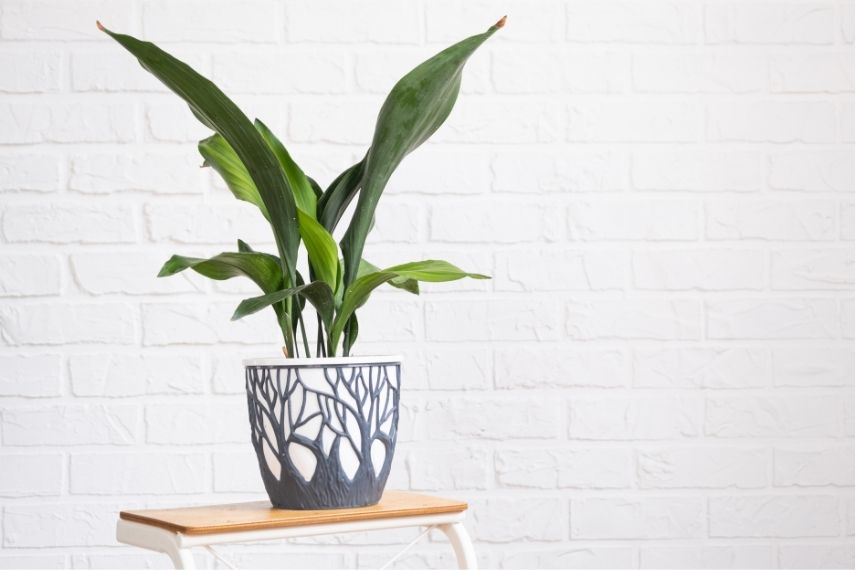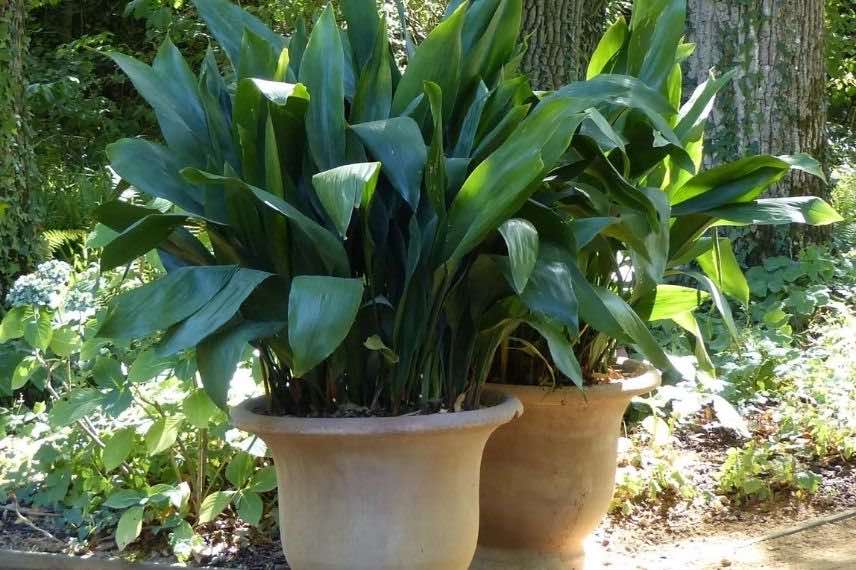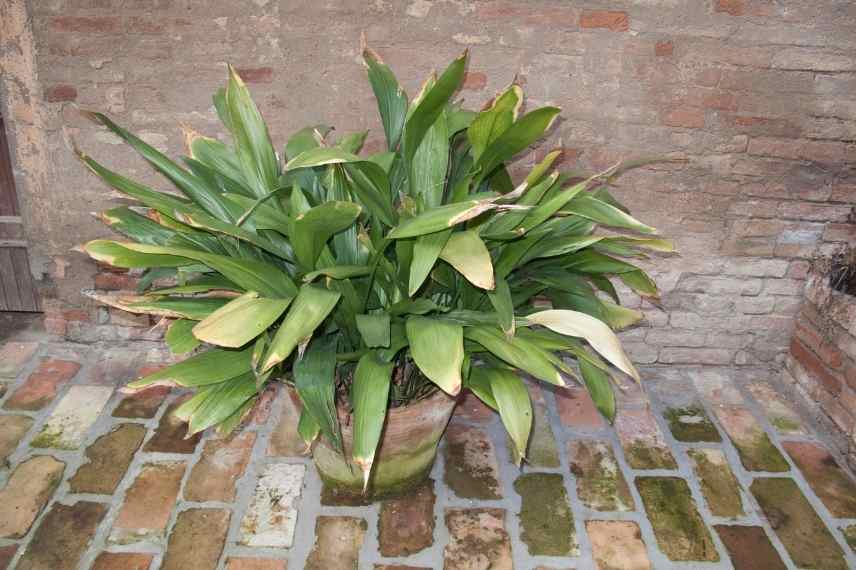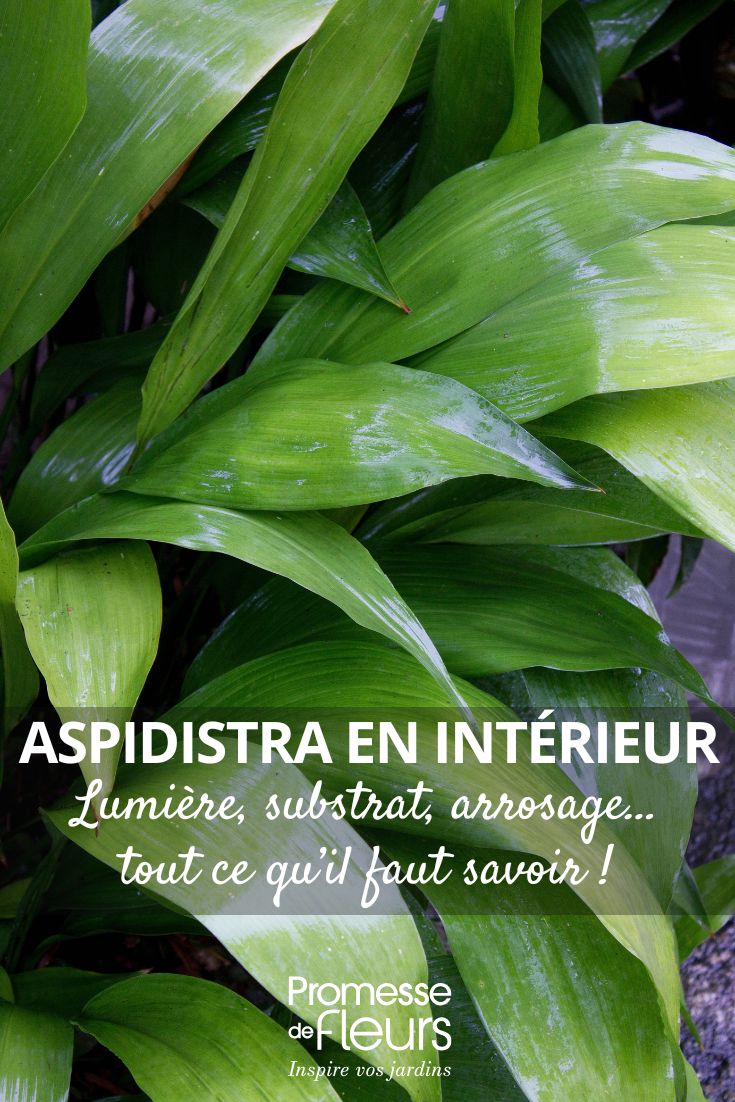
Aspidistra Indoors: Seasonal Care Guide
Our tailored advice for the "Mother-in-law's Tongue
Contents
The Aspidistra, or Cast Iron plant (Aspidistra eliator), is often nicknamed “Cast Iron plant” by English speakers for its robustness, or “Mother-in-law’s tongue” in our region, much like the Sansevierias. It is a beloved houseplant prized for its great adaptability and its striking, evergreen foliage. Native to Asia, it has become a staple in many homes thanks to its tolerance for moderate light conditions and low maintenance requirements. Although renowned for its ease of cultivation, its well-being still depends on seasonal care tailored to its needs.
Understanding the Aspidistra’s needs throughout the year not only helps keep it healthy but also promotes steady, balanced growth. This article offers seasonal guidance; discover all our tips for providing the most suitable care, from spring to winter.
Spring – The Awakening of the Aspidistra
After the winter months when the Aspidistra enters dormancy, the return of milder temperatures and longer days gradually stimulates the plant’s growth. This season is ideal for giving it special attention and performing the necessary care for its healthy development.
Repotting
If the Aspidistra hasn’t been repotted for two to three years, spring is the most favourable season for this task. Repotting is recommended when the roots begin to surface or emerge through the drainage holes. It’s best to choose a pot slightly larger than the previous one, with holes to facilitate water drainage.
The ideal substrate is a light, well-draining potting mix, such as a houseplant compost, possibly mixed with some perlite to improve aeration. Avoid choosing a pot that’s too large, as this could lead to excess moisture in the compost, which may harm the Aspidistra’s thick rootstock.
Resuming watering
During winter, watering is infrequent. In spring, you can resume watering more regularly, but without overdoing it. It’s advisable to let the compost dry out between waterings. The Aspidistra, being very hardy, is quite drought-tolerant, and it’s better to underwater slightly than to overwater.
Fertilisation
From April onwards, it’s recommended to apply fertiliser to support renewed growth. A liquid fertiliser for houseplants, diluted in the watering water once a month, helps strengthen the plant and encourage new leaf growth.
Leaf maintenance
Spring is also the time to clean the foliage. Aspidistra leaves tend to accumulate dust, which can hinder photosynthesis. Simply wipe them gently with a soft cloth or a damp sponge. Avoid using leaf shine products, as they can clog the stomata.
Monitoring growth
Finally, it’s useful to observe the plant during this period of regrowth. The appearance of young shoots indicates that the Aspidistra is actively growing. It’s also important to check for any signs of parasitic pests or diseases so you can take action quickly if needed.

A young Aspidistra with healthy new shoot growth
Summer – A Time of Active Growth for the Aspidistra
Summer marks the most vigorous growth phase of the Aspidistra. During this period, the plant takes full advantage of natural light and higher temperatures to develop new leaves. It then requires slightly more regular attention, though without needing complex care.
Regular and moderate watering
In summer, water needs increase due to heat and light intensity. Always allow the substrate to dry out completely between waterings, but you’ll notice it dries much faster, especially during particularly hot spells.
Watering about once or twice a week is recommended, but this is just a general guideline. Adjust the frequency according to ambient conditions like temperature or room humidity levels, and observe the plant carefully.
The Aspidistra dislikes excess water. It’s therefore essential to empty the saucer after each watering to prevent the roots from sitting in stagnant water, which could lead to rotting.
Nutrient supply
Fertilisation should continue throughout summer to support the plant’s active growth. A liquid fertiliser for green plants, applied once a month, remains suitable. This supplement helps maintain dense foliage with good colour. During heatwaves, stop fertilising.
Moving the plant outdoors
If conditions allow, you can consider moving the Aspidistra outdoors during the hottest months (as it’s perfectly possible to grow it outdoors year-round except in cold regions, since it can withstand temperatures down to -12°C). However, it tolerates neither direct sunlight nor wind. It’s therefore essential to place it in a shaded, sheltered spot protected from draughts. A north- or east-facing balcony or terrace may be suitable, provided the plant is well protected.
Monitoring overall health
During summer, it’s important to monitor the foliage’s condition. Signs like brown tips, spots or yellowing may indicate watering issues, over-fertilisation or excessive light exposure.
→ The Aspidistra enjoys bright light exposure but without direct sunlight. It also tolerates medium light conditions.
The appearance of parasites like mealybugs or aphids, though rare on Aspidistras, should also be monitored, particularly when outdoors.

The plant can be moved outside during the warmer season
Autumn – A Transition Towards Rest
Autumn marks the end of the active growth period for the Aspidistra. As light declines and temperatures drop, the plant naturally slows its activity. This is a transitional period during which it’s advisable to gradually adjust care to prepare the plant for winter.
Gradual reduction of watering
With shorter days and cooler temperatures, water needs decrease. It’s best to space out watering gradually, always checking the moisture of the substrate and allowing the compost to dry before watering again. A frequency of every ten to fifteen days may suffice, depending on indoor conditions (heating, ambient humidity, exposure).
End of fertilisation
It is also recommended to stop fertilising from early autumn. The plant enters a phase of relative dormancy and no longer requires additional nutrients. Fertilisation should resume the following spring, when growth naturally restarts.
Winter preparation
Autumn is an ideal time to observe the plant and perform some maintenance tasks:
-
Clean the leaves with a damp cloth to remove accumulated dust.
-
Remove damaged or yellowed leaves to prevent them from becoming a breeding ground for disease.
-
Check for parasites, especially if the plant has spent the summer outdoors.
If the plant has been moved outside during the warmer months, it’s time to bring it back indoors. It should be placed away from cold draughts and significant temperature fluctuations.
Final adjustments
Repotting the Aspidistra in autumn is not advised, except in emergencies (degraded substrate, parasite infestation, broken pot, etc.). This operation is better tolerated in spring, when the plant resumes its growth.

Remove damaged or yellowed leaves before winter
Winter – The Time for Rest
During winter, the Aspidistra enters a phase of vegetative rest. This period of dormancy is essential for its balance, and it requires little intervention. The main focus should be on maintaining stable conditions and limiting care to avoid disrupting its natural rhythm.
Reduced watering
Water requirements are minimal during winter. Watering should be significantly reduced: once every two to three weeks may suffice, or even less depending on environmental conditions.
In heated homes, the ambient air can become dry, but the Aspidistra tolerates it relatively well. If the air is particularly dry (below 40% humidity), you can lightly mist the foliage, without overdoing it.
No fertiliser needed
During the winter period, as the plant is dormant, there is no need to apply fertiliser. Feeding will resume in spring, along with growth.
Position and care
The Aspidistra can tolerate a minimum of 13°C in winter.
Even when dormant, it’s useful to keep an eye on the plant’s general condition: yellowing foliage, unusual spots or signs of wilting may indicate overwatering or an environmental issue.
- Subscribe!
- Contents
































Comments